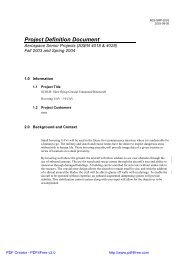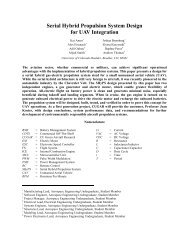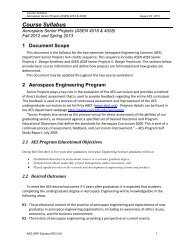PFR - Aerospace Engineering Sciences Senior Design Projects ...
PFR - Aerospace Engineering Sciences Senior Design Projects ...
PFR - Aerospace Engineering Sciences Senior Design Projects ...
You also want an ePaper? Increase the reach of your titles
YUMPU automatically turns print PDFs into web optimized ePapers that Google loves.
Project Final Report – CUDBF April 30 th , 2009<br />
ASEN 4028: <strong>Aerospace</strong> <strong>Senior</strong> <strong>Projects</strong><br />
dropping one rocket in between each lap. The first lap will be flown at 12 lbs, and the last lap<br />
will be flown at 7.5 lbs, with a 1.5 lb rocket being dropped in between each landing and takeoff.<br />
The batteries must be designed for a four lap endurance plus a 30 second power reserve.<br />
6.4 Structures <strong>Design</strong>-To Specifications<br />
6.4.1 Aircraft Wing Requirements<br />
The aircraft wing is required to sustain a +3.5g load while carrying the centerline store and a -2g<br />
load while carrying the tip stores. The required g loads were determined by including an<br />
additional 1 g of load to the worst case expected scenario for each payload. The worst case wing<br />
loading scenarios were derived from the expected in-flight bank turns the aircraft must make<br />
during each of the missions. The addition of the g loading margin creates a 1.4 safety factor for<br />
the centerline store flight scenario and a safety factor of 2 for the tip store flight scenario. The<br />
safety factor added to the worst expected loading is an added margin for unexpected factors<br />
including in-flight wind gusts and ideal assumptions made for the wing material and<br />
construction.<br />
The aircraft wing is required to fit within the aircraft container while still meeting the wingspan<br />
and payload integration requirements. This requires the wing be foldable or collapsible for incontainer<br />
storage due to the 48” x 24” x 24” dimensions specified by the competition. To<br />
guarantee the aircraft wing does not exceed the maximum container dimensions, the aircraft’s<br />
maximum dimensions on each side shall be 1” shorter than the container’s dimensions. With the<br />
maximum wing dimensions bound to 47” x 23” x 23”, a margin of safety was assured for this<br />
dimension requirement. This margin accounts for the thickness of the walls as well as some free<br />
space on any side of the aircraft in the container.<br />
The wing structure is also required to integrate the wingtip and centerline stores such that they<br />
are securely restrained in the worst case flight loading with some safety factor. The worst case g<br />
loading is expected to be a 2.5g bank turn and 1g of safety factor was added to that loading. A<br />
3.5g loading generates 28 lbs at the centerline store mount and 10.5 lbs at each wingtip store<br />
mount. The additional 1g included in the design wing loading creates a safety factor of 1.4 for<br />
each payload’s mounting point.<br />
6.4.2 Landing Gear Requirements<br />
The aircraft landing gear and supporting aircraft structure is required to survive the impact loads<br />
involved during landing. A successful mission requires that the aircraft survive take-off, flight,<br />
and landings. The landing gear requirement dictates that each gear strut survive a dynamic<br />
loading assumed to be approximately 3 times the heaviest aircraft weight configuration. Landing<br />
the plane on one gear in the heaviest configuration was deemed the worst case landing scenario.<br />
The 3g single gear strut loading includes a safety factor of 1.2 during the heaviest aircraft<br />
configuration and a safety factor of 2.25 in a no payload configuration. An additional 25%<br />
50
















